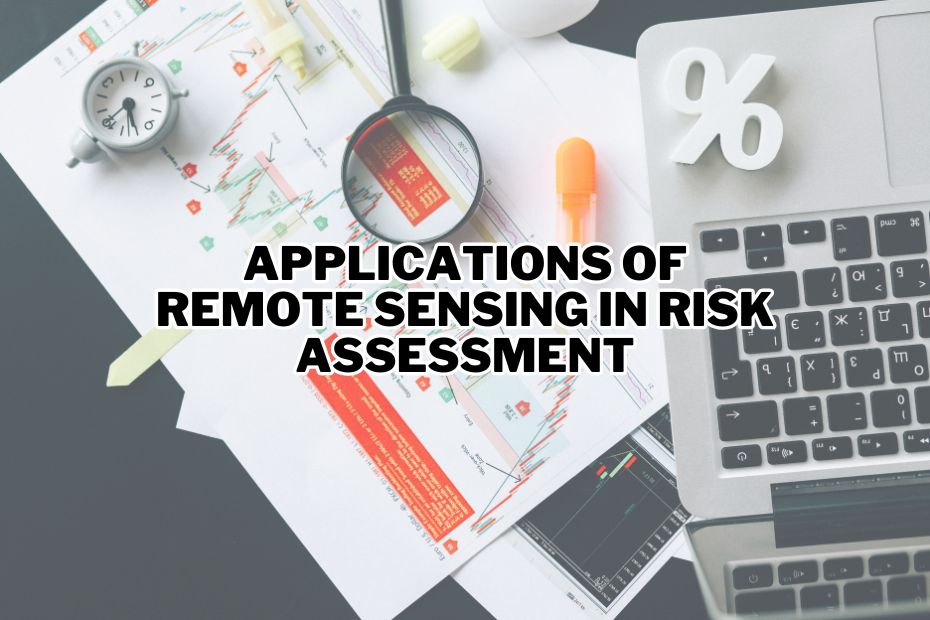In today’s rapidly evolving world, risk assessment has become a critical component of decision-making in various sectors, including agriculture, environmental management, disaster monitoring, and urban planning. Remote sensing, a technology that allows data collection from a distance, has emerged as a powerful tool to aid in risk assessment across a wide range of applications. In this article, we will explore ten application of remote sensing in risk assessment and how this technology is transforming the way we mitigate potential threats and uncertainties.
Remote sensing is widely used in risk assessment across various sectors. It aids in monitoring crop health, assessing environmental changes, predicting natural disasters, and supporting urban planning. This technology provides critical data for informed decision-making in risk management.
Application of Remote Sensing In Risk Assessment
Now, let’s delve into each of these applications in more detail:
1. Agricultural Risk Assessment
Monitoring Crop Health
Remote sensing provides valuable data for assessing crop health by capturing images of agricultural fields at various wavelengths. This allows farmers to identify areas of stress, nutrient deficiencies, or disease outbreaks, enabling timely interventions to protect crop yields.
Drought Prediction
Remote sensing helps in monitoring soil moisture levels, which is crucial for predicting droughts. By analyzing satellite data, scientists can assess the severity of drought conditions and provide early warnings to farmers and water resource managers.
Pest and Disease Management
Remote sensing aids in the early detection of pests and diseases affecting crops. By identifying affected areas through imagery analysis, farmers can target interventions, such as pesticide application, more effectively.
2. Environmental Risk Assessment
Deforestation Detection
Satellite imagery plays a crucial role in monitoring deforestation activities. By tracking changes in forest cover over time, remote sensing helps authorities combat illegal logging and assess the environmental impact.
Pollution Monitoring
Remote sensing technology can detect and monitor sources of pollution, including air and water pollution. This data assists in identifying areas with high pollution levels, facilitating mitigation measures.
Coastal Erosion Analysis
Coastal regions are vulnerable to erosion due to rising sea levels. Remote sensing helps assess the rate of erosion and plan coastal protection measures accordingly.
3. Disaster Risk Management
Flood Monitoring and Prediction
Remote sensing is instrumental in monitoring river levels and detecting potential flood areas. Real-time data allows authorities to issue timely warnings and plan evacuation efforts.
Earthquake Damage Assessment
After an earthquake, remote sensing can quickly provide high-resolution images of affected areas. This aids in assessing damage, prioritizing rescue efforts, and planning for reconstruction.
Wildfire Detection
Satellite imagery is crucial for detecting wildfires in their early stages. This allows for rapid response and the coordination of firefighting efforts.
4. Urban Planning and Infrastructure
Land Use Planning
Remote sensing data assists urban planners in evaluating land use patterns, identifying suitable locations for development, and optimizing city layouts.
Infrastructure Vulnerability Analysis
Assessing the vulnerability of infrastructure to natural disasters, such as hurricanes or floods, is critical for disaster preparedness. Remote sensing helps identify weak points in infrastructure systems.
5. Climate Change Impact Assessment
Glacier Monitoring
Remote sensing is used to monitor changes in glaciers, providing valuable data on the rate of ice melt and contributing to our understanding of climate change.
Sea Level Rise Analysis
By tracking changes in sea levels, remote sensing helps coastal communities plan for rising waters and implement adaptation strategies.
6. Humanitarian Aid and Crisis Response
Refugee Camp Management
During humanitarian crises, remote sensing can assist in managing refugee camps by assessing population movement and planning resource distribution.
Food Security Monitoring
Remote sensing helps monitor agricultural productivity in regions facing food security challenges. This data aids in targeted food assistance programs.
7. Biodiversity Conservation
Habitat Assessment
Remote sensing technology assists in mapping and monitoring biodiversity-rich habitats, helping conservationists protect endangered species.
Illegal Logging Detection
Satellite imagery is used to identify and combat illegal logging activities, helping preserve vital ecosystems.
8. Mining and Resource Management
Environmental Impact Assessment
Before and after mining activities, remote sensing provides insights into environmental changes, helping regulators enforce responsible mining practices.
Vegetation Monitoring
Remote sensing aids in tracking changes in vegetation cover due to mining operations, ensuring the restoration of disturbed areas.
9. Healthcare and Disease Tracking
Epidemic Surveillance
Remote sensing can play a role in tracking the spread of diseases, especially in remote or inaccessible areas, assisting health organizations in containment efforts.
Vector-Borne Disease Control
By monitoring environmental conditions that favor disease vectors, remote sensing helps predict and control vector-borne diseases like malaria and Zika virus.
Conclusion
Remote sensing technology has revolutionized risk assessment across various domains. Its ability to provide timely, accurate, and actionable data has made it an indispensable tool for decision-makers, researchers, and humanitarian organizations. As we continue to face a changing world with evolving risks, remote sensing will undoubtedly play an even more significant role in helping us make informed choices and mitigate potential threats.
FAQs: Application of Remote Sensing In Risk Assessment
How does remote sensing benefit agriculture in risk assessment?
Remote sensing helps monitor crop health, predict droughts, and manage pests and diseases, improving agricultural risk assessment.
Can remote sensing technology be used for disaster preparedness?
Yes, remote sensing aids in flood monitoring, earthquake damage assessment, and wildfire detection, enhancing disaster risk management.
What role does remote sensing play in climate change impact assessment?
Remote sensing is crucial for monitoring glaciers, sea level rise, and other climate-related changes, contributing to our understanding of climate change impacts.
Is remote sensing technology applicable to healthcare and disease tracking?
Yes, remote sensing can be used for epidemic surveillance and controlling vector-borne diseases, especially in remote areas.
